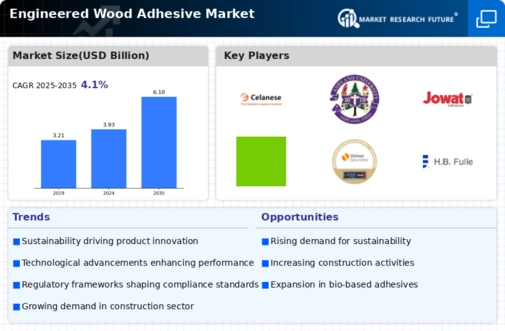Market Growth Projections
The Global Engineered Wood Adhesive Market Industry is poised for substantial growth, with projections indicating a market value of 3.93 USD Billion in 2024 and an anticipated increase to 6.1 USD Billion by 2035. This growth trajectory suggests a robust compound annual growth rate (CAGR) of 4.08% from 2025 to 2035. The expansion of the market is likely driven by various factors, including technological advancements, rising urbanization, and increasing demand for sustainable construction practices. As the industry evolves, stakeholders are expected to adapt to changing consumer preferences and regulatory requirements, positioning themselves for success in this dynamic market.
Sustainable Construction Practices
The Global Engineered Wood Adhesive Market Industry is experiencing a notable shift towards sustainable construction practices. As environmental concerns gain traction, builders and manufacturers are increasingly opting for engineered wood products that utilize adhesives with lower environmental impact. This trend is supported by regulations promoting eco-friendly materials, which are expected to drive the market's growth. In 2024, the market is projected to reach 3.93 USD Billion, reflecting a growing preference for sustainable solutions. The adoption of engineered wood adhesives aligns with the construction industry's commitment to reducing carbon footprints, thereby enhancing the demand for these products globally.
Regulatory Support for Wood-Based Products
Regulatory frameworks supporting the use of wood-based products are positively impacting the Global Engineered Wood Adhesive Market Industry. Governments are implementing policies that encourage the use of sustainable materials in construction, which includes engineered wood products. These regulations often promote the use of adhesives that meet specific environmental standards, thereby enhancing market growth. As the construction industry adapts to these regulations, the demand for engineered wood adhesives is likely to increase. This trend aligns with the projected market growth, with estimates indicating a rise to 3.93 USD Billion in 2024, as stakeholders seek compliance with evolving regulations.
Rising Demand for Prefabricated Structures
The Global Engineered Wood Adhesive Market Industry is witnessing a surge in demand for prefabricated structures, which are increasingly favored for their efficiency and cost-effectiveness. Engineered wood products, bonded with advanced adhesives, are essential in the construction of these structures, as they provide the necessary strength and stability. The trend towards off-site construction is gaining momentum, particularly in urban areas where space is limited. This shift is expected to propel the market forward, as prefabricated buildings often require high-performance adhesives to ensure structural integrity. Consequently, the market is poised for growth, with a projected CAGR of 4.08% from 2025 to 2035.
Growing Urbanization and Infrastructure Development
Urbanization and infrastructure development are key drivers of the Global Engineered Wood Adhesive Market Industry. As populations in urban areas continue to rise, there is an increasing need for housing and commercial spaces, which in turn fuels the demand for engineered wood products. These products, often bonded with specialized adhesives, are preferred for their lightweight properties and ease of installation. Governments worldwide are investing in infrastructure projects, further stimulating the market. The anticipated growth in urbanization is expected to contribute to the market reaching 6.1 USD Billion by 2035, highlighting the critical role of engineered wood adhesives in modern construction.
Technological Advancements in Adhesive Formulations
Innovations in adhesive formulations are significantly influencing the Global Engineered Wood Adhesive Market Industry. Advances in chemistry and material science have led to the development of adhesives that offer superior bonding strength, durability, and resistance to moisture and temperature fluctuations. These technological improvements not only enhance product performance but also expand the application range of engineered wood products. As a result, manufacturers are increasingly investing in research and development to create high-performance adhesives. This trend is expected to contribute to the market's growth, with projections indicating a rise to 6.1 USD Billion by 2035, driven by enhanced product offerings.



















